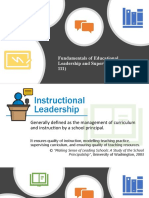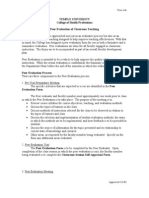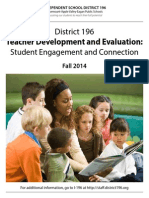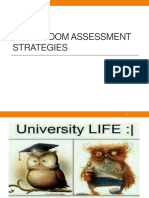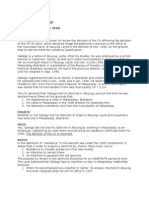0 ratings0% found this document useful (0 votes)
14 views Evaluation of Instructional Elements
Evaluation of Instructional Elements
Uploaded by
kevinthefuture50This document discusses self-reflection and evaluation instruments for teachers. It describes designing self-reflection instruments, getting feedback from learners, and implementing teacher and school self-evaluation. The importance of school audits and strategic planning is also explained.
Copyright:
© All Rights Reserved
Available Formats
Download as PPT, PDF, TXT or read online from Scribd
Evaluation of Instructional Elements
Evaluation of Instructional Elements
Uploaded by
kevinthefuture500 ratings0% found this document useful (0 votes)
14 views16 pagesThis document discusses self-reflection and evaluation instruments for teachers. It describes designing self-reflection instruments, getting feedback from learners, and implementing teacher and school self-evaluation. The importance of school audits and strategic planning is also explained.
Original Description:
Unit 9 assessment notes
Copyright
© © All Rights Reserved
Available Formats
PPT, PDF, TXT or read online from Scribd
Share this document
Did you find this document useful?
Is this content inappropriate?
This document discusses self-reflection and evaluation instruments for teachers. It describes designing self-reflection instruments, getting feedback from learners, and implementing teacher and school self-evaluation. The importance of school audits and strategic planning is also explained.
Copyright:
© All Rights Reserved
Available Formats
Download as PPT, PDF, TXT or read online from Scribd
Download as ppt, pdf, or txt
0 ratings0% found this document useful (0 votes)
14 views16 pages Evaluation of Instructional Elements
Evaluation of Instructional Elements
Uploaded by
kevinthefuture50This document discusses self-reflection and evaluation instruments for teachers. It describes designing self-reflection instruments, getting feedback from learners, and implementing teacher and school self-evaluation. The importance of school audits and strategic planning is also explained.
Copyright:
© All Rights Reserved
Available Formats
Download as PPT, PDF, TXT or read online from Scribd
Download as ppt, pdf, or txt
You are on page 1of 16
Evaluation of instructional elements
• Objectives: Students should be able to:
• Design self-reflection instruments
• Design instruments to get feedback from learners on
instructional issues
• Design teacher self-evaluation
• Discuss the proper implementation of instruments
• Explain and apply teacher self-evaluation instrument
and school self-evaluation
• Explain the importance of school audits and strategic
planning reflect on feedback and consider feedback
and consider improvement.
Self-reflection instruments
• In teaching profession, honest is a key.
• As teachers, we must regularly reflect on our
work.
• Self-reflection vs self-evaluation.
• Self-reflection is philosophical or broader
thinking. About what am I believing and how
well am doing it.
• Self-reflection: is about careful thought about
your own behaviour and beliefs.
• Reflective practitioner!!
• Self-evaluation: refers to individuals
assessment of themselves.
• It requires individuals to evaluate and monitor
own performance in relation to identified
criteria or standards.
Self-reflection instrument for
teachers
• Where did I fail as a teacher in the past?
• What is my teaching goal for the upcoming
academic year?
• What can I do to be proactive? (pages 225-
226)
• Look at subject specific teacher self-reflection
on pages 226-228.
• All these gives us of what could be done and
how to do it.
Self evaluation instruments: Its
benefit to teachers
• Reflect on development since 2005 in terms of
ETSIP, NPST and National Standards and
Performance Indicators for schools.
It evaluates issues related to:
Subject administration
Lesson preparation
Lesson presentation and
Other important issues a teacher must attend
(pp.230-231).
Benefits of self-instrument to
teachers
• It helps to improve teaching and learning
• It could lead to teachers finding their own
teaching strengths and weaknesses
• It indicates how well or how bad the teacher is
doing
• It could lead to better reflection
• It could lead to general self-improvement
• It helps to measure some degree of accuracy
of attitudes or behaviours
• It helps the teacher to organize official
documents, such as syllabi and scheme of
work
• It helps the teacher to become well organised
by creating files e.g. preparation and resource
file
• It leads to improvement in lesson preparation
• It creates conducive learning environment in
class
• It helps to set academic performance targets
• It leads to quality lesson planning and
preparation
• It makes teacher to attend to resources such
as:
– Providing more teaching materials in classroom
• It allows the teacher to seek for external
support.
• It makes the teacher to provide more
continuous assessment.
Questionnaire feedback from learners
and parents
• Debate about validity of feedback from
learners
• Too young to understand the complexity of
teaching.
• However, good opportunity to get feedback
from customers.
• Encourage teachers to embrace the use of
questionnaire and how to design them
(Student-lecturer evaluation?).
Implementation of feedback
• Decide on what you want to get feedback on.
• It may help improve your teaching.
• Explain its purposes to learners
• Request honest opinion – completion should
be voluntarily.
• Feedback is anonymous.
• Not test- do not need to copy others’ views.
• When ready to discuss it – start with the
positive.
• Address the negatives – try to understand the
reasons behind the negatives.
School audits and strategic planning
• Allow you to reflect on own teaching-learning
practices with the use of instruments and
feedback from stakeholders.
• Audit could be done yearly to identify
anomalies that block effective teaching and
achievement.
• School could audit themselves or externally.
• Staff, learners and parents provide useful
information.
After that devise an action schedule by
focusing on:
Critical performance areas
Devise a strategic planning of the school
o Complex thing to do – external professional.
Strategic plan focus on how to manage the
future
School audit how to fix current challenges.
Link it to the current system: National
Standards and Performance Indicators for
Schools in Namibia
The School Self-Evaluation Instrument focuses
on 7 key areas namely:
Resources
Curriculum and attainment
Teaching and learning
The school as social unit
Management and leadership
Links with parents and the community
Links with other school and the region.
Under each of these areas there are key
performance indicators and themes/aspects
to be achieved.
You might also like
- SDO Navotas TLE10 CSS Q3 M2 Installing-And-Configuring-Computer-Systems FVaDocument10 pagesSDO Navotas TLE10 CSS Q3 M2 Installing-And-Configuring-Computer-Systems FVaRey Lacdan Glendro100% (1)
- Levels of Curriculum PlanningDocument9 pagesLevels of Curriculum Planningclara dupitas50% (2)
- 1) Supplementary Information Requirment Sheet - Pvt. Ltd.Document1 page1) Supplementary Information Requirment Sheet - Pvt. Ltd.hoshen mollaNo ratings yet
- Eps 444 T.P.E Unit 3Document25 pagesEps 444 T.P.E Unit 3EnochNo ratings yet
- Elo 2 3 2024Document18 pagesElo 2 3 2024kevinthefuture50No ratings yet
- (Sar) Self Assessment RecordDocument19 pages(Sar) Self Assessment RecordTimoy AlinabonNo ratings yet
- Assessment For LearningDocument28 pagesAssessment For LearningEne JosephNo ratings yet
- Role of Assessment in LearningDocument18 pagesRole of Assessment in Learningmonishamonisha2306No ratings yet
- Week 13 Interaction Between Curriculum, Instruction, and AssessmentDocument28 pagesWeek 13 Interaction Between Curriculum, Instruction, and AssessmentVivid MagazineNo ratings yet
- Guidelines For Developing A Faculty Evaluation ProcessDocument17 pagesGuidelines For Developing A Faculty Evaluation ProcessNoe ZalamedaNo ratings yet
- Assessment Under The K To 12 For Private SchoolsDocument89 pagesAssessment Under The K To 12 For Private Schoolsrichard alicawayNo ratings yet
- Oct 20 PresentationDocument23 pagesOct 20 Presentationapi-268382136No ratings yet
- How To Write Learning ObjectivesDocument59 pagesHow To Write Learning Objectivesneshalvin7No ratings yet
- ELO 1.2 1.3 Discuss The Underlying Philosophies and Approaches To AssessmentDocument19 pagesELO 1.2 1.3 Discuss The Underlying Philosophies and Approaches To Assessmentkevinthefuture50No ratings yet
- 21CLD - Self RegulationDocument16 pages21CLD - Self RegulationAnkur AgrawalNo ratings yet
- Effective Learning Class Room - EvaluationDocument16 pagesEffective Learning Class Room - EvaluationSheraz Ilyas100% (1)
- Instructional LeadershipDocument22 pagesInstructional LeadershipghaNo ratings yet
- The Role of Assessment in TeachingDocument3 pagesThe Role of Assessment in TeachingRhea M. Lucena100% (2)
- AED3701 Study Guide SummariesDocument25 pagesAED3701 Study Guide SummariesLelani RoetsNo ratings yet
- Assessment For LearningDocument18 pagesAssessment For LearningJebishaNo ratings yet
- Formative Assessment PresentationDocument34 pagesFormative Assessment Presentationapi-279184573No ratings yet
- Nine Characteristics of High Performing Schools PresentationDocument26 pagesNine Characteristics of High Performing Schools PresentationV.ShivaNo ratings yet
- Gsm11es Unit 2Document28 pagesGsm11es Unit 2mphopitsokingtoyNo ratings yet
- Unit 6 For BSC NursingDocument55 pagesUnit 6 For BSC NursingSaima ParveenNo ratings yet
- Concepts and Principles of Organization, Administration, and SupervisionDocument28 pagesConcepts and Principles of Organization, Administration, and SupervisionRainiel Victor M. CrisologoNo ratings yet
- Concepts and Principles of Organization, Administration, and SupervisionDocument28 pagesConcepts and Principles of Organization, Administration, and SupervisionAliejah CasanNo ratings yet
- Things To Consider in Planning InstructionDocument28 pagesThings To Consider in Planning InstructiondaisylodorNo ratings yet
- Job Description (Vice Principal)Document2 pagesJob Description (Vice Principal)Hina AmeerNo ratings yet
- Effective Management of Teaching and LearningDocument25 pagesEffective Management of Teaching and LearningMARIA CONSOLACION VITERBONo ratings yet
- External ExaminationDocument16 pagesExternal Examinationrejoice international100% (1)
- 9am - Too Many Mandates Using The Ib As A Framework For Streamlining SuccessDocument76 pages9am - Too Many Mandates Using The Ib As A Framework For Streamlining SuccessBindu M PillaiNo ratings yet
- LECTURE 3 Continuous AssessmentDocument26 pagesLECTURE 3 Continuous Assessmentmanqobak60No ratings yet
- Marking and AssessmentDocument10 pagesMarking and Assessment113pa2023nnNo ratings yet
- Unit 7 Feedback and ReportingDocument20 pagesUnit 7 Feedback and Reportingkevinthefuture50No ratings yet
- Pindics EnglishDocument11 pagesPindics EnglishAbhimanyu MaheshwariNo ratings yet
- Bishop Challoner Catholic Collegiate School: StatementDocument6 pagesBishop Challoner Catholic Collegiate School: StatementBCCCSNo ratings yet
- Assesment and Evaluation LearningDocument182 pagesAssesment and Evaluation Learninghambisatiruneh6No ratings yet
- Towards Self Evaluation of A TeacherDocument18 pagesTowards Self Evaluation of A TeacherMaureen Taguba Sta AnaNo ratings yet
- Educ 108 Chapter 1Document50 pagesEduc 108 Chapter 1Liezel AlquizaNo ratings yet
- Class Assessment & EvaluationDocument19 pagesClass Assessment & EvaluationNur LaelaNo ratings yet
- Use FeedbackDocument1 pageUse Feedbackapi-254080736No ratings yet
- Concepts of Curriculum and Purposes of Curriculum StudyDocument24 pagesConcepts of Curriculum and Purposes of Curriculum StudyGita Rahmi100% (1)
- Prelim - Introduction To ASLR 2Document16 pagesPrelim - Introduction To ASLR 2jsembodo4582qcNo ratings yet
- Assessment Under The K To 12 For TLE TEACHERSDocument86 pagesAssessment Under The K To 12 For TLE TEACHERSJie Jams Manipis100% (3)
- Teacher Evaluation MethodsDocument8 pagesTeacher Evaluation MethodsTeresa MendesNo ratings yet
- Peer Evaluation FormDocument9 pagesPeer Evaluation Formnursinginstructo2012No ratings yet
- TdaebrochurefallDocument8 pagesTdaebrochurefallapi-287826317No ratings yet
- What Is Lesson Plan ReviewedDocument8 pagesWhat Is Lesson Plan ReviewedaliahtarmiziNo ratings yet
- Professional Development PlanDocument45 pagesProfessional Development PlanAshraf AtiqueNo ratings yet
- Lecture Two 26-07-2024 Concept of Assessment (2) (Autosaved) (Autosaved)Document26 pagesLecture Two 26-07-2024 Concept of Assessment (2) (Autosaved) (Autosaved)manqobak60No ratings yet
- Curriculum and Assessment Part 1 2024Document19 pagesCurriculum and Assessment Part 1 2024manqobak60No ratings yet
- Evaluation LearningDocument5 pagesEvaluation LearningkirrtNo ratings yet
- Child Ed 204 Sept 17 2022Document20 pagesChild Ed 204 Sept 17 2022Bernyl Grace Dormitorio - PanaguitonNo ratings yet
- SES5MO86N6NF55K2N Action Research Cairo 2024Document48 pagesSES5MO86N6NF55K2N Action Research Cairo 2024Hend AshrafNo ratings yet
- Providing For Effective TeachingDocument34 pagesProviding For Effective TeachingyanaNo ratings yet
- Green and Blue Playful Visual Arts Class Education PresentationDocument34 pagesGreen and Blue Playful Visual Arts Class Education PresentationangelNo ratings yet
- Standards PresentationDocument26 pagesStandards Presentationapi-284227922No ratings yet
- 006 Classroom Assessment StrategiesDocument54 pages006 Classroom Assessment StrategiesasmaNo ratings yet
- AASSA Teacher Evaluation SystemDocument16 pagesAASSA Teacher Evaluation SystemLuz Angela ZamoraNo ratings yet
- Assessment PolicyDocument15 pagesAssessment Policyapi-343608586No ratings yet
- Assessment Under The K To 12 For TLE TEACHERSDocument87 pagesAssessment Under The K To 12 For TLE TEACHERSMANILYN GUMBANNo ratings yet
- Teachers’ Perceptions of Their Literacy Professional DevelopmentFrom EverandTeachers’ Perceptions of Their Literacy Professional DevelopmentNo ratings yet
- UNIT 6 P. 99 - 109 (1) Curriculum Notes (Education)Document24 pagesUNIT 6 P. 99 - 109 (1) Curriculum Notes (Education)kevinthefuture50No ratings yet
- ELO 1.2 1.3 Discuss The Underlying Philosophies and Approaches To AssessmentDocument19 pagesELO 1.2 1.3 Discuss The Underlying Philosophies and Approaches To Assessmentkevinthefuture50No ratings yet
- Elo 1Document129 pagesElo 1kevinthefuture50No ratings yet
- ELO 4.1 Importance of A ConstitutionDocument17 pagesELO 4.1 Importance of A Constitutionkevinthefuture50No ratings yet
- Systemic ApproachDocument63 pagesSystemic Approachkevinthefuture50No ratings yet
- Introduction and Psychoanalytic ApproachDocument79 pagesIntroduction and Psychoanalytic Approachkevinthefuture50No ratings yet
- Unit 4Document23 pagesUnit 4kevinthefuture50No ratings yet
- CF81 06 Nor 2019Document14 pagesCF81 06 Nor 2019kevinthefuture50No ratings yet
- Guidelines For Teachers For Setting and Marking AssessmentsDocument38 pagesGuidelines For Teachers For Setting and Marking Assessmentskevinthefuture50No ratings yet
- Unit 7 Feedback and ReportingDocument20 pagesUnit 7 Feedback and Reportingkevinthefuture50No ratings yet
- Culture 23 April 2024Document18 pagesCulture 23 April 2024kevinthefuture50No ratings yet
- Elements of Culture HandoutDocument13 pagesElements of Culture Handoutkevinthefuture50No ratings yet
- ELO 4 Structure of The Namibian GovernmentDocument12 pagesELO 4 Structure of The Namibian Governmentkevinthefuture50No ratings yet
- Study GuideDocument229 pagesStudy Guidekevinthefuture50No ratings yet
- ELO 4.2 Human Rights and Fundametal FreedomsDocument21 pagesELO 4.2 Human Rights and Fundametal Freedomskevinthefuture50No ratings yet
- ConceptsDocument1 pageConceptskevinthefuture50No ratings yet
- Gender Issues in Classroom Assessment LessonDocument24 pagesGender Issues in Classroom Assessment Lessonkevinthefuture50No ratings yet
- A Detailed Lesson Plan in Grade IX ScienceDocument4 pagesA Detailed Lesson Plan in Grade IX ScienceAdrian Tastar100% (1)
- Guidelines On Writing A Narrative Report in Student Internship Program in The Philippines (Sipp)Document12 pagesGuidelines On Writing A Narrative Report in Student Internship Program in The Philippines (Sipp)Karl Russell BayotNo ratings yet
- DLP in English 4 Week 6 Day 4Document1 pageDLP in English 4 Week 6 Day 4John Carlo DinglasanNo ratings yet
- Ian Stevenson - Similarity of Features of Reincarnation Type Cases 2003Document7 pagesIan Stevenson - Similarity of Features of Reincarnation Type Cases 2003vic1101100% (2)
- Chapter Three: System Analysis, Design and ImplementationDocument18 pagesChapter Three: System Analysis, Design and ImplementationFlash WestNo ratings yet
- Pengaruh Teknologi Informasi Terhadap Kecerdasan (Intelektual, Spiritual, Emosional Dan Sosial) Studi Kasus: Anak-AnakDocument12 pagesPengaruh Teknologi Informasi Terhadap Kecerdasan (Intelektual, Spiritual, Emosional Dan Sosial) Studi Kasus: Anak-AnakGalih Sangra AdiyugaNo ratings yet
- Police Visibility at Barangay Calingayan, Sinait, Ilocos SurDocument10 pagesPolice Visibility at Barangay Calingayan, Sinait, Ilocos SurLeah Mae YadaoNo ratings yet
- Invention-Making The World A Better Place: For 9-To 12-YEAR-OLDS in Afterschool ProgramsDocument48 pagesInvention-Making The World A Better Place: For 9-To 12-YEAR-OLDS in Afterschool ProgramsRahim KhanNo ratings yet
- Agile Process ModelsDocument13 pagesAgile Process ModelsRoel CaedoNo ratings yet
- Module 3 - PhiloDocument18 pagesModule 3 - PhiloCressia Mhay BaroteaNo ratings yet
- Day 1Document34 pagesDay 1itzddcryptoNo ratings yet
- Science Lesson PlanDocument5 pagesScience Lesson PlanAnaliza CatingobNo ratings yet
- Mishandling of Sexual Harassment Complaints at Symbiosis Law School, HyderabadDocument3 pagesMishandling of Sexual Harassment Complaints at Symbiosis Law School, HyderabadFirstpostNo ratings yet
- MAY SF EBOOK v2Document41 pagesMAY SF EBOOK v2Fayçal AmraniNo ratings yet
- BIOL 2010 Syllabus Fall 2020Document7 pagesBIOL 2010 Syllabus Fall 2020Jennifer BlackNo ratings yet
- Integry TestingDocument5 pagesIntegry TestingVahmi Brian Owen D'sullivansevenfoldimerzNo ratings yet
- Introduction To Nursing Research and Importance of The Course in NursingDocument1 pageIntroduction To Nursing Research and Importance of The Course in NursingAdiel CalsaNo ratings yet
- Activity Guide LAC SESSIONDocument4 pagesActivity Guide LAC SESSIONPsyche Lanielle PalaparNo ratings yet
- Legal Bases of Teaching ProfessionDocument78 pagesLegal Bases of Teaching ProfessionAl Patrick ChavitNo ratings yet
- Gallego vs. Vera - Residence QualificationDocument2 pagesGallego vs. Vera - Residence QualificationElaine Atienza-IllescasNo ratings yet
- 21 Magnetic Forces and Fields 1Document11 pages21 Magnetic Forces and Fields 1jonathan stevenNo ratings yet
- Barry Case SolutionDocument2 pagesBarry Case SolutionSadiaNo ratings yet
- CITYgreen Workshop Brochure PrintDocument2 pagesCITYgreen Workshop Brochure Printarchiveproject.01No ratings yet
- Experience Optimization PlaybookDocument33 pagesExperience Optimization Playbookravitechno.us100% (2)
- Research Title Proposal Sample 1Document8 pagesResearch Title Proposal Sample 1Ashley FrineNo ratings yet
- UNICAM Call PHD Ciclo XL - EN - DEF - SignedDocument16 pagesUNICAM Call PHD Ciclo XL - EN - DEF - Signedmubshiiir87565No ratings yet
- Poe 3.1Document6 pagesPoe 3.1OSCAR SUY-PEREZNo ratings yet
- Basic Elements of PoetryDocument1 pageBasic Elements of PoetryMa. Fe Evangeline SaponNo ratings yet
















